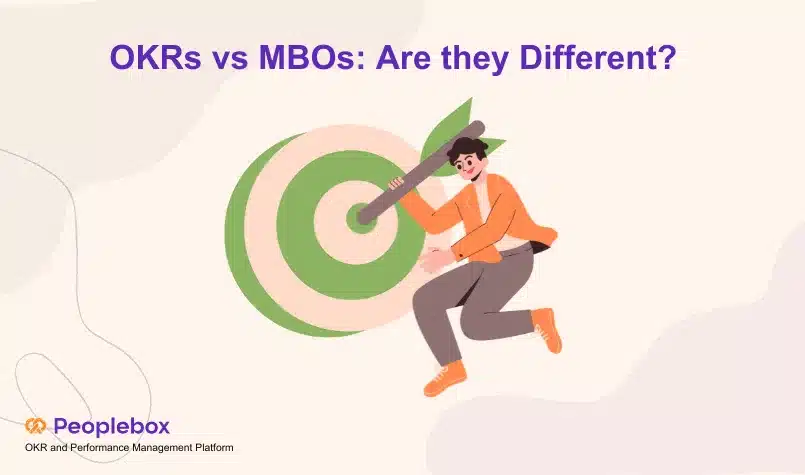What are MBOs and OKRs?
‘Setting goals is the first step in turning the invisible into the visible’
– Tony Robbins
On one side of the ring, the old guard stands, an MBO-structured top-down approach. Across from it is the spry challenger, OKR, conceived for flexibility and rapid growth. For all its excellent-looking tailoring, MBO feels a bit stiff, classic, yet reliable. OKR, on the other hand, is like your favorite pair of sneakers: dynamic, fast-paced, and built for innovation.
So, which one should your business wear? Let’s break down these two frameworks and see which can elevate your organization’s goals from good to game-changing. Here goes the big takedown of OKR vs MBO.
MBOs (Management by Objectives) technique was developed by Peter Drucker in the year 1950 with a human nature approach. That means MBO goals are personalized to identify a team’s primary objective or goal and help to set a priority between outcome and activity.
OKRs are a refined form of MBO and they provide more clarity by giving a broad idea about what success means to the organization.
OKRs help teams attain their objectives through measurable key results. OKRs provide purpose to teams and organizations.
OKR VS MBO: How are they different?
Both OKR and MBO works differently when coming to structure, orientation, and implementation of goals. Here is a detailed preview of how OKR and MBO are different from each other.
1️⃣Difference in Structure
In MBO, the objectives are written in detailed form but how to reach those objectives is not clear. In OKRs, the Objective is about what you want to accomplish and what is the timeline to achieve it.
Key Results refer to the actionable plan of action that helps you to reach the objective. Key Results breaks the objectives into specific metrics by quantifying them. These KRs can be used to measure the achievement of the Objectives.
2️⃣Difference in Orientation
MBO technique is used more to assign individual goals but on the contrary, OKRs are more about team alignment on goals.
As MBOs are assigned to individuals they are discussed between an employee and their manager, while OKRs are communicated to every team member openly.
MBO performance affects an employee’s salary while OKR does not as it is not much about individual performance but more about the company’s objective and how each team member contributes to those objectives.
3️⃣Differences in Execution
MBOs are annual goals wherein OKRs are set mostly every quarter which allows goals to stay prioritized. Annual goals can detract the focus and often there are chances that MBO will lose priority and focus.
MBO progress is communicated behind closed doors by the manager to the employee. OKR updates on the other hand are shared openly between the teams. The culture of transparency is inculcated through this.
MBOs as said earlier are set yearly and are generally set at the beginning of the year and remain the same throughout. But in OKR key results and objectives can be modified according to the challenges and scenarios the teams are in.
4️⃣Difference in Direction
As such, the objectives of MBO-managed companies are cascaded from top to bottom (top-down). The MBO goals are also set only once per cycle, usually a year, by the leadership, which are passed on to the employees. Work for the employees is only on achieving the goals set during this time. Usually, there is no say in the setting of goals.
The OKR approach, on the other hand, respects the reality of our complex environment: it is rarely predictable, dynamic, and characterized by ambiguity (VUCA). With OKR, management determines the overall goals of the company – but the goals of the teams and departments are largely determined by the employees in a bottom-up approach.
5️⃣Difference in Accessibility
In MBO-led firms, as a matter of rule, only the executives and the responsible employees know the respective objectives. In this, transparency is ruled out since it is an agreement between superiors and employees, which is confidential.
This leads to two essential issues: the information silos and, due to this, the lack of communication and collaboration.
Employees only have a well-defined set of tasks in front of them that won’t change much, with clearly defined objectives and an annual time horizon. It is relatively very infrequent that communication and coordination with the remaining team members or departments only is needed.
In contrast, OKRs have very public, transparent team goals with a high need for coordination. MBOs keep their employees relatively in isolation, whereas OKRs create a firework of communication and collaboration to contribute jointly toward the initiatives and goals. Silos get broken down, synergies are identified, and duplication of work is avoided.
6️⃣Differences in Leadership and Collaboration
Besides paralyzing intrinsic motivation, another weakness of the exact coupling of compensation to goals is that these MBO goals will be set rather conservatively. This is the logical result of the coupling: employees set goals so high that just they surely can realize them.
After all, this is the only way they will achieve increases in their salaries and bonuses. The result of this incentive thus creates goals set artificially low, which may lead to quite serious problems regarding the performance of the organization.
On the other side, OKR motivates ambitious goals by clearly separating compensation. Here, while MBO goals are to be met 100% of the time, OKRs offer something more to the employee for achieving a goal of 60-70%, which again is the reason for celebration.
How are they different?OKR vs MBO Differences explained with an example
Here are examples of OKRs and MBOs categorized by different business functions, such as Marketing and Sales:
1. Marketing Example
– OKR:
- Objective: Boost brand awareness.
- KR1: Increase website traffic by 40% within the next quarter.
- KR2: Grow social media followers by 30% across all platforms.
- KR3: Achieve a 15% engagement rate on social media posts.
– MBO:
- Objective: Achieve marketing campaign goals.
- Target: Generate 1,000 new leads through the upcoming product launch campaign.
2. Sales Example
– OKR:
- Objective: Increase sales revenue.
- KR1: Achieve $500,000 in new sales by the end of Q2.
- KR2: Increase average deal size by 20%.
- KR3: Close 50 new accounts this quarter.
– MBO:
- Objective: Meet sales targets.
- Target: Reach a quarterly sales target of $1 million.
3. Customer Support Example
– OKR:
- Objective: Enhance customer satisfaction.
- KR1: Achieve a customer satisfaction score of 90% or higher.
- KR2: Reduce average response time to under 1 hour.
- KR3: Resolve 95% of support tickets on the first contact.
– MBO:
- Objective: Improve customer service efficiency.
- Target: Decrease average handling time for support calls to 5 minutes.
4. Product Development Example
– OKR:
- Objective: Accelerate product launch.
- KR1: Complete product development within the next 3 months.
- KR2: Conduct 10 user testing sessions before launch.
- KR3: Achieve a 90% satisfaction rating from beta testers.
– MBO:
- Objective: Deliver product updates.
- Target: Roll out three major product updates this year.
5. Human Resources Example
– OKR:
- Objective: Improve employee engagement.
- KR1: Achieve an employee satisfaction score of 85% or higher in the annual survey.
- KR2: Increase participation in company training programs by 50%.
- KR3: Implement three new employee recognition initiatives.
– MBO:
- Objective: Meet recruitment goals.
- Target: Hire 10 new employees by the end of the quarter.
Pros and Cons of OKRs and MBOs
Knowing the advantages and disadvantages of OKR vs. MBO can help you understand which of these goal-setting frameworks is best suited for your organization. Let’s glance over these below.
Pros and Cons of OKR
Pros
- Quick setting of goals
- Versatile and adaptable
- Promotes creativity and innovation
- Promotes team cooperation, alignment, and transparency
Cons
- Still has to endure periods of review and presentation of results.
- Need to be constantly up-to-date and in line with the changing environments.
- Training curriculums as well as a knowledgeable workforce involved in bringing out an efficient outcome
Pros and cons of MBOs
Pros
- Clearly defines precise roles for the employees
- Motivates people to be dedicated and result-oriented Develops a cordial relationship between the managers and the employees
Cons
- Inflexible to changing circumstances
- It requires skilled managers to become effective
- It calls for commitment, which would have to be long-term.
Why do Organizations prefer OKR over MBO?
Organizations should have a focus on their overall efforts. The OKR cycle starts with the thought of choosing the most important thing for the organization in the next three months. OKRs enable the leaders to provide their team with a compass and baseline for assessment.
Today, it has been very essential for organizations to align all their day-to-day activities with the vision and mission of the organization. The OKRs enable organizations to demarcate distant objectives into shorter-term achievable objectives.
Success in organizations depends on more than one factor. The quantitative key results being connected to the qualitative key results OKRs protect against the harm that can be wrought by success at any point.
Although MBOs and OKRs have been highly in use throughout the years, organizations are more inclined toward the OKRs for the reasons elaborated above.
Conclusion
OKR is a more advanced form of goal-setting method. The only challenging part is that it is new to many and people are still adapting to this goal-setting approach. It takes a few cycles for teams to frame OKRs but once understood it is the best goal-setting technique for any organization.
With Peoplebox, implementing OKRs becomes seamless and effective!
Our platform empowers teams to set clear, measurable objectives and align them with key results, fostering a culture of accountability and transparency. Say goodbye to ambiguity and hello to focused execution!
Peoplebox not only simplifies the OKR process but also offers real-time tracking and insights, enabling teams to adjust and stay on course. Our user-friendly interface ensures that everyone—from executives to individual contributors—understands their goals and contributions, creating a unified vision.
Join the ranks of successful companies that have embraced the OKR framework with Peoplebox. Let us help you unlock your team’s potential, enhance productivity, and achieve your strategic objectives. Start your journey toward a high-performing culture today! Click here for a product tour!






